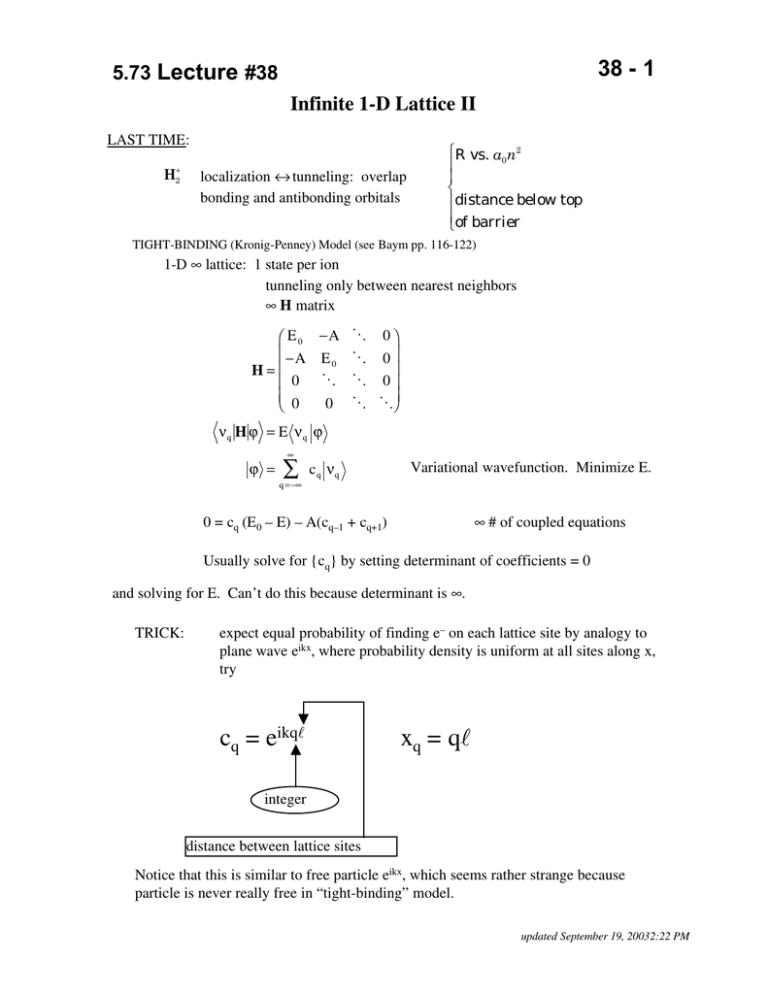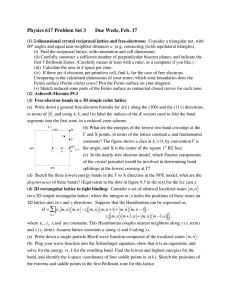38 - 1 Lecture 5.73 #38
advertisement

38 - 1
5.73 Lecture #38
Infinite 1-D Lattice II
LAST TIME:
H2+
localization ↔ tunneling: overlap
bonding and antibonding orbitals
R vs. a0n2
distance below top
of barrier
TIGHT-BINDING (Kronig-Penney) Model (see Baym pp. 116-122)
1-D ∞ lattice: 1 state per ion
tunneling only between nearest neighbors
∞ H matrix
E 0 −A
−A E
0
H=
0
O
0
0
O 0
O 0
O 0
O O
νq H ϕ = E νq ϕ
ϕ =
∞
∑
c q νq
Variational wavefunction. Minimize E.
q =−∞
∞ # of coupled equations
0 = cq (E0 – E) – A(cq–1 + cq+1)
Usually solve for {cq} by setting determinant of coefficients = 0
and solving for E. Can’t do this because determinant is ∞.
TRICK:
expect equal probability of finding e– on each lattice site by analogy to
plane wave eikx, where probability density is uniform at all sites along x,
try
cq = eikql
xq = ql
integer
distance between lattice sites
Notice that this is similar to free particle eikx, which seems rather strange because
particle is never really free in “tight-binding” model.
updated September 19, 20032:22 PM
38 - 2
5.73 Lecture #38
2
cq = 1
plug trial form for c q into 0 = c q (E 0 − E ) − A(c q −1 + c q +1 )
0 = e ikq (E 0 − E ) − Ae ikq (e − ik + e + ik
l
l
l
l
)
divide through by e ikq
l
(
)
0 = E0 − E − A2 cos kl
E ( k) = E0 − 2 A cos kl
E(k)
E 0 + 2A
E0 —
−π
0
l
E 0 − 2A
+π
l
k
E varies continuously over an interval 4A, where A is the adjacent site interaction strength
or the “tunneling integral”
What happens when we look at k outside -π/l ≤ k < π/l
“1st Brillouin Zone”
ck = e ikq
l
k′ = k +
ck ′ = e
2π
l
2π
i k + ql
l
(one additional
wavelength per
lattice spacing l)
= e ikq e i 2 πq = e ikq
l
l
wavefunction is unchanged!
So if k goes outside 1st Brillouin Zone, get same ψ, so get same E
nothing new!
No point in allowing k to vary more widely than –π/l ≤ k ≤ π/l.
updated September 19, 20032:22 PM
38 - 3
5.73 Lecture #38
Unanswered Questions:
1.
How many distinct orbitals are there in a band?
N-atom periodic array. Periodic Boundary conditions:
longest λ = lN
N possible value of λ = 2 π / k
shortest λ = l
2π
2π
≤k≤
in N steps
lN
l
–π
π
infinite lattice:
< k < contains all the states generated
l
l
from one state per atom.
2.
What happens at E > E0 + 2A?
gap – no states allowed
next higher state of each atom?
free particle if E > work function
3.
Orbitals not states! Two spin-orbitals per orbital.
Antisymmetrization.
Lowest band: all spins paired. No G term.
e– – e– repulsion raises overall E above that of single state
of each atom
Work function is smaller than single atom IP
4.
How many e– does each atom contribute to ψ?
alkali: 1e– ∅ half full band
alkaline earth: 2e–∅ full band
updated September 19, 20032:22 PM
38 - 4
5.73 Lecture #38
Now take a closer look at ϕ k ( x )
ϕ( x ) = x ϕ k =
+∞
x νq
∑ e ikq 1
23
q = −∞
l
ν q( x )
ν q ( x ) = ν 0 ( x − ql )
shift x by –ql to get
from site q to site 0
ϕ k ( x ) = ∑ e ikq ν 0 ( x − ql )
l
q
translate entire ϕ by l
ϕ k ( x + l ) = ∑ e ikq ν 0 ( x − ql + l )
14
4244
3
q
ν 0 ( x − ( q − 1) )
l
l
= e ik
l
∑
q
(
e ik q − ν 0 x − (q − 1)l
(
)
1
l
)
re-index summation
ϕ k ( x + l ) = e ik
l
∑
q
e ikq ν 0 ( x − ql ) = e ik ϕ k ( x )
l
l
translation of
plane wave by l
implies that it is possible to write ϕ k ( x ) in more general form
ϕ k ( x ) = e ikxuk ( x )
where uk ( x + l ) = uk ( x )
Bloch wave function
perodicity of l
e ikx conveys translational symmetry of plane wave with wavevector k
uk ( x ) conveys translational symmetry of lattice with spacing l
updated September 19, 20032:22 PM
38 - 5
5.73 Lecture #38
Localized time dependent state :
wavepacket
We are gong to build intuitive insight by comparison to free particle.
Recall free particle:
Ψ ( x, t ) = (2 π)
−1/ 2
∫
(k ) e i[ kx − E ( kωt)t / h ]
dk g{
envelope
of k
centered
at k 0
Group velocity: motion of stationary phase point (stationary with respect to k near k0)
d
[kx − Et / h] k = k 0
dk
dE
t h
x center (t ) =
dk k 0
0=
v center =
k0
v center
1
k0 h
2 2
k
2m
2
h k0
=
m
E=
dE
dk
dE
dk
d
take
dt
h
1 dE
= vG =
h dk
hk 0
= m
k0
free particle
relationship
between
vG and hk,m
use this to
understand
motion in a
periodic lattice
updated September 19, 20032:22 PM
38 - 6
5.73 Lecture #38
Up to here we have been analyzing the free particle.
for 1–D lattice
Ψ(t ) = (2 π) −1/ 2 ∫ dkg{
(k )e − iE( k )t / ϕ k
h
peak
at k 0
instead of asking for location of stationary phase point, ask for time dependent overlap of Ψ(t)
with specific lattice site νq⟩.
νq Ψ(t ) = (2 π) −1/ 2 ∫ dk g(k )e i[ kq
l
because ϕ k =
∞
∑e
ikql
− E ( k )t / h ]
νq
q =−∞
∞
ikq
φ
(
x
)
=
e
x
|
ν
same
thing
as
∑
k
q
q =−∞
We can use either
state vector or
wavefunction picture.
l
and νq picks out only the e ikq term
l
because νp νq = δ pq
recall that x = ql, so we can think of νq Ψ (t ) as function of x, t
Overlap of Ψ (t) with particluar lattice site νq . Ψ (t) moves and
sequentially overlaps succesive lattice sites.
meaningful only for
regions of x near ql
ν q Ψ(t) = χ ( x ,t) = (2π)
−1/2
∫
dkg ( k)e i [ kx − E( k )t / ]
h
real part
phase factor
ask for stationary phase factor (near x = 0, ±l, ±2l, …) with respect to k
updated September 19, 20032:22 PM
38 - 7
5.73 Lecture #38
d
0 = [kx − E (k )t / h]
dk
dE
t /h
x c (t ) =
dk k 0
dx c dE
vG =
=
dt
dk
1
Up to here, everything is identical for free
particle and motion in a periodic lattice.
k0 h
E (k ) = E 0 − 2 A cos kl
dE
dk
wavepacket is created
centered at k=k0
Now use E×k relationship derived for
periodic (tight binding) lattice.
= 2 Al sin k 0l
k0
vG =
2 Al
h
sin k 0l
quite different from
plane wave result
hk
VG = 0
m
Note that vG = 0 when k0 is at bottom (k0 =
0) or top (k0= ±π/l) of band.
updated September 19, 20032:22 PM
38 - 8
5.73 Lecture #38
Building of intuition:
* vG ∝ A
[as | A | increases it becomes easier to take a step]
* v G ∝ l (but A ↓ as l ↑)
(because tunneling rate decreases as l
increases) but if A is kept constant as l
increases, each step is longer so velocity will
be higher
* v G = 0 when k 0 = 0 and when k 0 = ±π / l
bottom of band
Not a surprise
because expect
k=0∅v=0
top of band
Big surprise.
Use concept of
”effective mass”
to rationalize.
e– cannot move if it is too close to edges of band
“Effective Mass:” free
k
vG =
m
h 0
vs.
vG =
lattice
2 Al sin k 0l
h
2 Al 2
≈ hk 0 2
h
at small k0l
sin k0l ≈ k0l
near
bottom of
band
compare the terms and identify reciprocal of the
coefficient of hk0:
meff =
h
2
2 Al 2
at small k 0l
* large interaction strength makes meff
small
* large l makes meff small (large jumps)
Next: How do we show that meff increases to ∞
at band edges (k = ±π / l)?
updated September 19, 20032:22 PM
38 - 9
5.73 Lecture #38
When k 0 is near ± π
k0 = ±
l
π
−ε
l
sin k 0l = sin ±
π
− ε l ≈ ±εl
l
2 Al
2 Al
v G = hk 0 2 sin k 0l ≈ ± hk 0 2 εl
h k0
h k0
2
h k0
meff =
→ ∞ as ε → 0
2 Al 2ε
Full band: no e – transport.
1 / 2 Full band: meff
2 h2
=
2 Al 2
(slightly heavier than at bottom of band)
Alternative approach to meff:
E = p 2 / 2m
d 2E
2
dp
for free particle
−1
=m
Use this to define meff
E(k) = E 0 − 2 A cos kl
E (p) = E 0 − 2 A cos(pl / h)
d 2E
2
2
(
) cos kl
=
A
2
/
l
h
2
dp
at small kl
meff =
h
cos kl = 1 − 12 (kl) 2 + …
2
2 Al 2
updated September 19, 20032:22 PM





